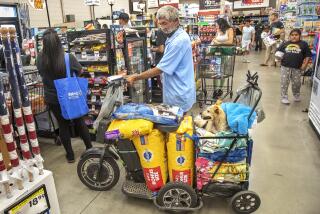Duty-free shoppers, make sure you’ve got rules on liquids in the bag
- Share via
Question: My husband and I recently returned from an overseas trip. We flew from Naples, Italy, to Vancouver, Canada, before our last leg to LAX. After we cleared security in Naples, we did some shopping in the duty-free store, where we bought two bottles of Italian olive oil. At checkout, the clerk scanned our ticket, then bagged our items to carry on the plane with us. All was fine until we reached Vancouver. The security personnel said that because the oil wasn’t bagged in a sealed bag they would have to take it. I had the items in the original bag from the duty-free store and the receipt, but they would not budge. When we were in Naples, all the bags were open tote-style bags. I did not see any kind of bag that would seal. The cost was minimal, but we were disappointed. If we had known this would happen, we would have purchased olive oil while shopping in town and packed it in our suitcases. We thought we were doing it the right way by shopping in the duty-free store. What is this all about?
Darby Ziegler
Huntington Beach
Answer: This is about the Transportation Security Administration’s rules, which have relaxed a bit.
“Relax” may be too strong a word, though, because although one regulation has changed, another has been added.
A TSA spokesman referred me to its website on which the modified rule is explained this way: You can now carry on liquids of 3.4 ounces or more on a connecting flight if they are in transparent containers, if your purchase was in a duty-free shop and (here’s the rub in this case) if they were placed in a secure, tamper-evident bag, or STEB. (I didn’t invent that acronym.)
You can see the rule at 1.usa.gov/1lmte4e.
From that page you scroll down to the link under “secure, tamper evident bags” and click through to the International Civil Aviation Organization (which calls itself a “U.N. specialized agency” that was “created in 1944 upon the signing of the Convention on International Civil Aviation [Chicago Convention]”). The website goes on to say that this organization “works with the convention’s 191 signatory states and global industry and aviation organizations to develop international Standards and Recommended Practices [SARPs] which are then used by states when they develop their legally binding national civil aviation regulations. “
You can read this and more at bit.ly/1trnv2n, but the gist from its website is this: “Efforts are underway in various states to develop and deploy new screening technology at airports capable of detecting hazardous substances within liquids, aerosols and gels (LAGs).
“In the meantime, the threat posed by LAGs has been addressed by issuing security control guidelines for carry-on LAGs, including specifications for secure tamper-evident bags suitable for in-flight and airport purchases.”
Or said another way, SARPs about LAGs lead to STEBs.
On that International Civil Aviation Organization page, you’ll see a small rendering of a STEB. When the rendering is enlarged (on your keyboard, you can hit “control” and the plus symbol to enlarge it), you can see that the bag says, “Do not open until final destination.” It also has a circle with a check mark that sort of looks like a happy face, which is not something you always associate with TSA rules.
The rendering isn’t easy to see, but it’s clear that a STEB doesn’t look anything like an open tote-style bag.
If you’re shopping at a duty-free shop, you need to know a STEB when you see one, or more important, when you don’t. For more clues about what the bags look like, just Google STEB and click on images. They will give you a better idea of what the bags look like, which is good because the TSA doesn’t.
Add this knowledge to the storehouse of information you now must have about what can be carried on. I’m especially flummoxed by the snow globe rule, which reads this way on the TSA website: “Snow globes that appear to contain less than 3.4 ounces of liquid [approximately tennis ball size] can be packed in your carry-on bag ONLY if the entire snow globe, including the base, is able to fit into your one quart-sized, resealable plastic bag. Each passenger can only bring one quart-sized bag with 3.4 oz or smaller containers.”
Depending on your snow globe, you might have to choose between your deodorant and your snow globe. If your flight is packed — and these days, they’re running about 83.3% full through April, according to the Bureau of Transportation Statistics — please make the right choice.
None of which helps Ziegler, who is out two bottles of oil. I asked the TSA whether she could have had her liquids repackaged at a duty-free shop in Vancouver, and the answer is no because duty-free in a country that didn’t sell the oil has no way of knowing whether the oil is just a cover-up for something more nefarious.
My shopping credo has always been that you regret only the things you don’t buy, but this case suggests the opposite. Before you finalize the purchase of goods at a duty-free shop, make sure the shop shows you how it will be packaged just to be sure it’s in the bag.
Have a travel dilemma? Write to travel@latimes.com. We regret we cannot answer every inquiry.
More to Read
Sign up for The Wild
We’ll help you find the best places to hike, bike and run, as well as the perfect silent spots for meditation and yoga.
You may occasionally receive promotional content from the Los Angeles Times.







